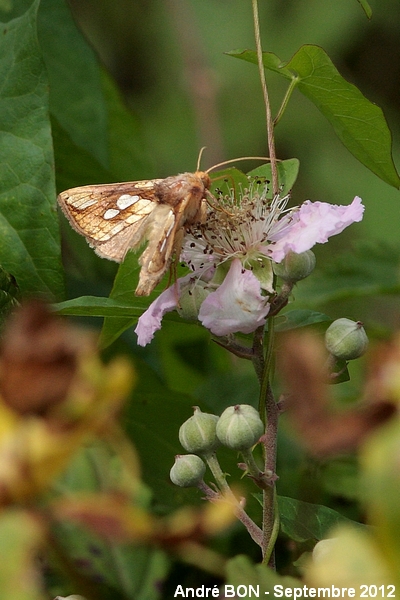
| Gold Spot (Plusia festucae (Linnaeus, 1758)) |

|
|
Scientific name: Plusia festucae (Linnaeus, 1758) Common name: Gold Spot French name: Plusie de la Fétuque Order: Lepidoptera Suborder: Heterocera Family: Noctuidae Subfamily: Plusiinae Wingspan: 34-36 mm. Biotope: Damp areas, damp meadows, marshes, river banks. Geographic area: Eurasia, from Ireland to Japan. Flight time: May-June then August-September. Number of generations : 2 (only 1 in the northern part of the range). Caterpillar: Green with 6 thin yellowish white dorsal and subdorsal lines and one broader yellowish white lateral stripe. Host plant: Many plants growing in damp places (Water Graminae, Iris sp, Carex sp, etc.) |
The Gold Spot has golden brown to yellowish brown fore wings. They bear two large silvery spots. The larger one is closer to the base. Both spots are tear-shaped and slightly elongated. There is a third silvery spot, almost straight-shaped, close to the apex of the wing, and a fourth one, small and rounded, at the base of the costal edge. The veins are slightly darker than the ground colour of the wings. You can also distinguish four straight and parallel dark brown stripes crossing the wings. The hind wings are yellowish grey. There is a possible confusion with the Lempke's Gold Spot (Plusia putnami). The two large silvery spots are less elongated on this last species. The larger one is quadrangular and the smaller one is rounded. The silvery mark close to the apex is shorter and wider than on the Gold Spot. |
| [To know more about the Gold Spot] [Top] |

|
The rather elongated shape of the marking close to the apex rather leads to the Gold Spot species than to the Lempke's Gold Spot species. The angle of view does not permit to have a good idea of the shape of the two central spots. |